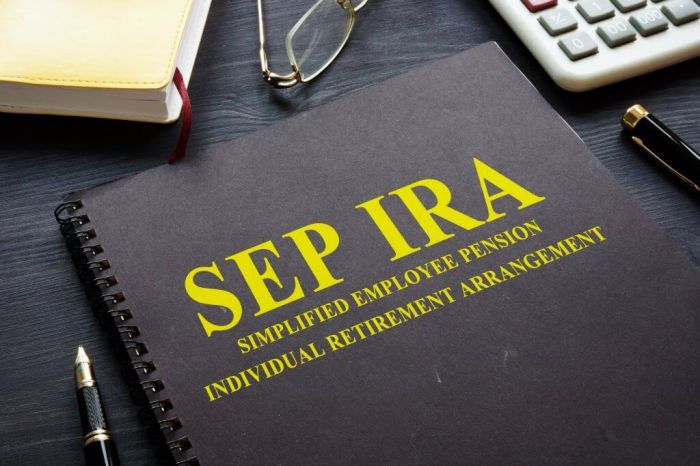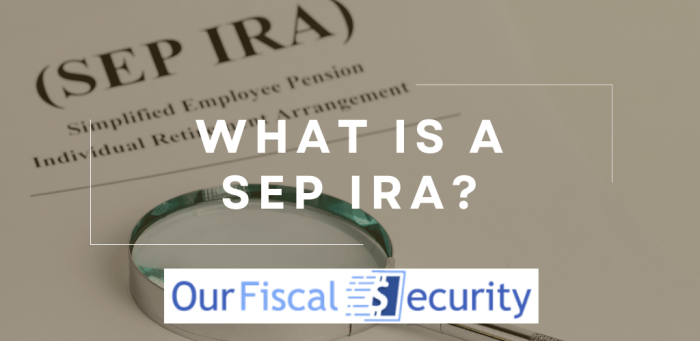Bank of America SEP IRA accounts offer a compelling retirement savings vehicle for self-employed individuals and small business owners. This guide delves into the intricacies of this account type, exploring its features, contribution limits, investment options, and withdrawal rules. We’ll also address crucial aspects like account management, security, and customer support, providing a holistic understanding of this powerful retirement planning tool.
Understanding the nuances of a Bank of America SEP IRA is key to maximizing its benefits and securing a comfortable financial future.
From establishing your account and making contributions to navigating investment strategies and managing withdrawals, we aim to provide clarity and actionable insights. This comprehensive overview will empower you to make informed decisions about your retirement savings, leveraging the resources and features offered by Bank of America.
Bank of America SEP IRA Account Features
A Bank of America SEP IRA (Simplified Employee Pension plan) offers a straightforward way for self-employed individuals and small business owners to save for retirement. This account type provides significant tax advantages and offers various investment options to suit different risk tolerances and financial goals. This section details the key features, benefits, and considerations of a Bank of America SEP IRA.
Account Features and Benefits
Bank of America SEP IRAs offer several key features, including online account management, a variety of investment choices, and the significant tax benefits associated with SEP IRA contributions. These features are designed to make retirement planning more accessible and efficient.
Tax Advantages: Contributions to a SEP IRA are tax-deductible, reducing your taxable income for the year. This can lead to significant tax savings, particularly for higher-income individuals. Growth within the account is also tax-deferred, meaning you won’t pay taxes on investment earnings until you withdraw them in retirement.
Fee Comparison: While specific fees vary depending on the investment options chosen, Bank of America’s fees are generally competitive with other major financial institutions offering SEP IRAs. It’s advisable to compare fee schedules directly with competing institutions before making a decision.
| Investment Option | Expense Ratio (Example) | Minimum Investment | Description |
|---|---|---|---|
| Bank of America Mutual Funds | 0.50% – 1.50% | $1000 | A wide range of diversified mutual funds catering to various investment styles. |
| Exchange-Traded Funds (ETFs) | 0.05% – 0.50% | $1000 | Access to low-cost, diversified market exposure through ETFs. |
| Individual Stocks | Commissions Apply | Varies | Direct investment in individual company stocks. |
| Bank of America Brokerage Services | Commissions Apply | Varies | Access to a wide range of securities through brokerage services. |
Contribution Limits and Rules
Understanding contribution limits and rules is crucial for maximizing the tax benefits of your SEP IRA and avoiding penalties. The contribution limit is adjusted annually by the IRS to account for inflation.
Contribution Limits: The maximum contribution to a SEP IRA is generally a percentage of your net self-employment income, with the percentage being set by the employer (in this case, yourself). For example, an employer may choose to contribute 20% of an employee’s net self-employment income. Consult the IRS website for the most up-to-date contribution limits.
Rules and Regulations: Contributions must be made by the tax filing deadline (including extensions). Exceeding the contribution limits can result in significant penalties. Proper record-keeping is essential to ensure compliance.
Implications of Exceeding Limits: Over-contributing to your SEP IRA can result in substantial penalties from the IRS. These penalties can include a significant tax on the excess contribution plus interest. It’s important to carefully track contributions and stay within the established limits.
Flowchart for Making a Contribution:
A flowchart would visually represent the steps involved in making a contribution: 1. Determine contribution amount; 2. Access online banking or visit a branch; 3. Initiate a transfer from your checking/savings account; 4. Specify SEP IRA account as destination; 5.
Confirm transaction.
Account Management and Access

Source: workablewealth.com
Bank of America provides convenient online and mobile access to manage your SEP IRA. Account statements, transaction history, and beneficiary information are readily available through these channels.
Online Access: You can access your account through Bank of America’s online banking platform or mobile app. This allows for 24/7 access to account information and transaction capabilities.
Account Statements and Transaction History: Downloadable statements and transaction histories are available online, providing a detailed record of your account activity.
Changing Beneficiary Information: The process for changing beneficiary information typically involves completing a designated form either online or through a branch visit.
Transferring Funds: Funds can be transferred from other Bank of America accounts or external accounts through online banking or by visiting a branch. Follow the online prompts or seek assistance from a bank representative for guidance.
Investment Strategies and Retirement Planning
Developing a sound investment strategy for your SEP IRA is crucial for long-term retirement success. This involves considering your risk tolerance, time horizon, and financial goals. This section will explore various investment strategies and options available within your Bank of America SEP IRA.
Investment Strategies and Options
Several investment strategies can be employed within a SEP IRA, each with its own risk and reward profile. These strategies should be tailored to individual circumstances and goals.
Investment Strategy Comparison: Conservative strategies focus on preserving capital and minimizing risk, often utilizing bonds and low-risk investments. Moderate strategies balance risk and return, using a mix of stocks and bonds. Aggressive strategies prioritize higher growth potential but accept greater risk, often concentrating on stocks.
Risk and Reward: Higher-return investments typically carry higher risk. Understanding this trade-off is critical when building an investment portfolio.
Planning your retirement with a Bank of America SEP IRA account? Understanding different banking structures is key. Consider the accessibility factor; for example, do you need in-person banking? Checking if does CIT Bank have branches might help you compare options. Ultimately, the best SEP IRA choice depends on your individual needs and banking preferences, so carefully weigh all your options before making a decision.
Diversification: Diversification is key to mitigating risk. Spreading investments across different asset classes (stocks, bonds, real estate, etc.) can help reduce the impact of losses in any single asset.
- Low Risk Tolerance: Focus on bonds, money market accounts, and low-volatility stocks.
- Moderate Risk Tolerance: Balance stocks and bonds, with a greater allocation towards stocks as the time horizon increases.
- High Risk Tolerance: Invest heavily in stocks, including growth stocks and potentially some alternative investments.
Withdrawal Rules and Penalties
Understanding withdrawal rules and potential penalties is crucial for avoiding unwanted tax consequences. Early withdrawals from a SEP IRA are generally subject to penalties and taxes.
Withdrawal Rules and Regulations: Generally, withdrawals before age 59 1/2 are subject to a 10% early withdrawal penalty, in addition to ordinary income tax on the withdrawn amount. Exceptions exist for certain circumstances, such as disability or death.
Tax Implications of Early Withdrawals: Early withdrawals are taxed as ordinary income, meaning they are subject to your regular income tax rate.
Penalties for Premature Withdrawals: The 10% early withdrawal penalty applies unless specific exceptions Artikeld by the IRS are met.
Permissible Early Withdrawals Without Penalty: Examples include death, disability, and certain qualified higher education expenses (under specific conditions).
Rollovers and Transfers

Source: ourfiscalsecurity.org
Rolling over or transferring funds from other retirement accounts into your Bank of America SEP IRA can streamline your retirement savings. This section Artikels the procedures and tax implications involved.
Rolling Over Funds: You can roll over funds from previous retirement accounts (such as 401(k)s or traditional IRAs) into your Bank of America SEP IRA, typically without incurring immediate tax penalties. Direct rollovers are generally preferred to avoid potential taxation.
Transferring Funds Between Accounts: Transfers between different Bank of America retirement accounts are usually straightforward and can be done online or through a branch.
Tax Implications: Rollovers are generally tax-free, but transfers may have tax implications depending on the specific accounts involved. Consult a tax advisor for personalized guidance.
| Rollover Option | Advantages | Disadvantages |
|---|---|---|
| Direct Rollover | Tax-free, streamlined process | Requires coordination between institutions |
| Indirect Rollover | More flexible timing | Subject to potential tax implications if not handled correctly |
Account Security and Customer Support: Bank Of America Sep Ira Account
Bank of America prioritizes the security of your SEP IRA account and provides various support channels to address your questions and concerns. This section details the security measures and customer support options available.
Account Security and Fraud Prevention
Bank of America employs robust security measures to protect your SEP IRA account from unauthorized access and fraud. These measures include encryption, multi-factor authentication, and fraud monitoring systems.
Security Measures: These include advanced encryption technology, regular security updates, and fraud detection systems.
Protecting Your Account from Fraud: Regularly review your account statements, monitor your credit reports, and be cautious of phishing scams.
Reporting Suspected Fraudulent Activity: Contact Bank of America immediately if you suspect any fraudulent activity on your account.
Recovering Access to a Compromised Account: Follow the instructions provided by Bank of America’s fraud department to regain access to your account.
Customer Service and Support, Bank of america sep ira account
Bank of America offers various channels for contacting customer support regarding your SEP IRA account. These channels include online resources, phone support, and branch visits.
Contacting Customer Support: Options include online chat, phone support, email, and in-person visits to a branch.
Response Times: Response times vary depending on the chosen support channel. Phone support generally offers the quickest response.
Online Resources: Bank of America’s website provides a wealth of information, FAQs, and helpful resources for SEP IRA account holders.
- Q: What are the contribution limits for a SEP IRA? A: Contribution limits are a percentage of your net self-employment income, set by the employer (yourself).
- Q: What are the tax implications of early withdrawals? A: Early withdrawals are subject to a 10% penalty and are taxed as ordinary income.
- Q: How can I access my account statements? A: Access statements online through Bank of America’s website or mobile app.
- Q: How do I change my beneficiary information? A: You can typically update this information online or by contacting customer support.
Conclusive Thoughts
Ultimately, a Bank of America SEP IRA can be a valuable tool for building a secure retirement. By carefully considering contribution limits, investment strategies, and withdrawal rules, self-employed individuals and small business owners can effectively utilize this account to achieve their financial goals. Remember to consult with a financial advisor to tailor your strategy to your specific circumstances and risk tolerance.
Proactive planning and informed decision-making are crucial for maximizing the long-term benefits of your SEP IRA.